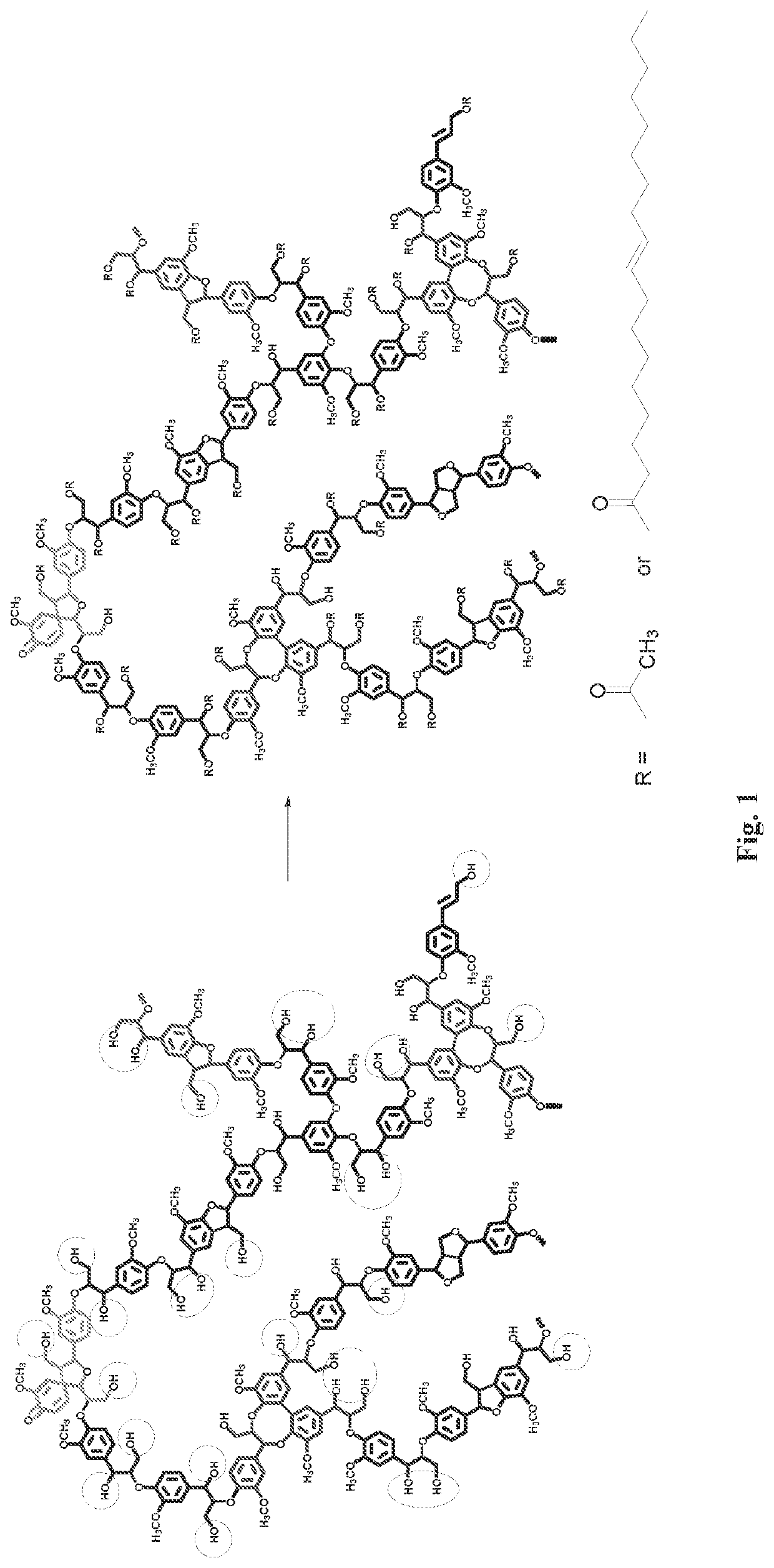Biobased hot-melt adhesive including lignin as a component
a hot-melt adhesive and biobased technology, applied in the direction of lignin adhesives, heat-activated film/foil adhesives, non-macromolecular adhesive additives, etc., can solve the problems of low molar mass, common degradation of these polymers, and inability to provide cohesive polymers. strength
- Summary
- Abstract
- Description
- Claims
- Application Information
AI Technical Summary
Benefits of technology
Problems solved by technology
Method used
Image
Examples
example 1
[0108]Lignin samples originating from different feedstock and biomass pretreatment processes were compounded in a laboratory scale compounder (Micro compounder DSM Xplore Micro 15 cc Twin Screw Compounder or DACA instruments) together with a cohesive polymer and a plasticizer as shown in Table 1.
TABLE 1Compounding and gluing performance of HMAs with unmodified lignin as tackifier.All formulations were compounded for 10 min resulting in uniform HMAs.GluingMaximum loadMaximum load / weightRatio of componentsCompoundingTorque,temperature,(180° peel test),(180° peel test),in HMA formulationT, ° C.N° C.NN / gCommercial HMA12010.5 ± 3.8 276CAOx / SW-Kraft Lignin 1 / TEC21 / 29 / 50130Not recorded1206.0 ± 0.913326 / 34 / 40160151606.6 ± 1.3142CAOx / SW-Kraft Lignin 2 / TEC21 / 29 / 501601606.7 ± 0.7335CAOx / Soda Lignin / TEC21 / 29 / 501601606.9 ± 0.7355CAOx / Alkox lignin(non-washed) / TEC21 / 29 / 501301403.9 ± 1.114426 / 34 / 401501708.8 ± 0.6191CAOx / Alkox lignin(acid washed) / TEC21 / 29 / 5016014010.0 ± 1.1 18526 / 34 / 401601605.8 ± 1....
example 2
[0114]An acetylated lignin sample was compounded in a laboratory scale compounder (DACA instruments) together with a cohesive polymer and a plasticizer as shown in Table 3 (below), together with the gluing parameters and performance. The properties of the lignin acetate sample are shown in the following Table 4 including glass transition temperature, degradation temperature and content and quality of hydroxyl groups. The methods are described in Example 1, and the preparation of the acetylated lignin after Table 4.
TABLE 3Compounding and gluing performance of HMAs with acetylated lignin as tackifier.All formulations were compounded for 10 min resulting in uniform HMAs.GluingMaximum loadMaximum load / weightRatio of componentsCompoundingTorque,temperature,(180° peel test),(180° peel test),in HMA formulationT, ° C.N° C.NN / gCommercial HMA1208.8 ± 0.6246CAOx / Acetylated Lignin / TEC30 / 40 / 30150Not recorded1208.7 ± 0.912226 / 34 / 40130Not recorded1208.4 ± 0.310021 / 29 / 50130Not recorded1208.2 ± 0.51...
example 3
[0116]An internally plasticized TOFA lignin was used for both components—tackifier and plasticizer together with oxidized cellulose acetate or commercial PCT. The gluing performance and properties of the TOFA lignin samples are shown in Table 5 and 6, respectively. The methods are described in Example 1, and the preparation of TOFA-lignin after the Table 6.
TABLE 5Compounding and gluing performance of HMAs with TOFA lignin as tackifier and plasticizer.All formulations were compounded for 10 min resulting in uniform HMAs.GluingMaximum loadMaximum load / weightRatio of componentsCompoundingTorque,temperature,(180° peel test),(180° peel test),in HMA formulationT, ° C.N° C.NN / gCommercial HMA1208.8 ± 0.6246CAOx / TOFA-L 10010 / 90130Not recorded1200.8 ± 0.29230 / 70140Not recorded1205.3 ± 0.710150 / 501601958.9 ± 1.4262CAOx / TOFA-L 9510 / 901501208.2 ± 0.5143CAOx / TOFA-L 7030 / 701601603.0 ± 0.935PCL / TOFA-L 10010 / 901001006.6 ± 1.622930 / 701001004.4 ± 0.9179
TABLE 6Properties of the used TOFA lignin sample....
PUM
| Property | Measurement | Unit |
|---|---|---|
| temperature | aaaaa | aaaaa |
| Tg | aaaaa | aaaaa |
| Tg | aaaaa | aaaaa |
Abstract
Description
Claims
Application Information
 Login to View More
Login to View More - R&D
- Intellectual Property
- Life Sciences
- Materials
- Tech Scout
- Unparalleled Data Quality
- Higher Quality Content
- 60% Fewer Hallucinations
Browse by: Latest US Patents, China's latest patents, Technical Efficacy Thesaurus, Application Domain, Technology Topic, Popular Technical Reports.
© 2025 PatSnap. All rights reserved.Legal|Privacy policy|Modern Slavery Act Transparency Statement|Sitemap|About US| Contact US: help@patsnap.com

